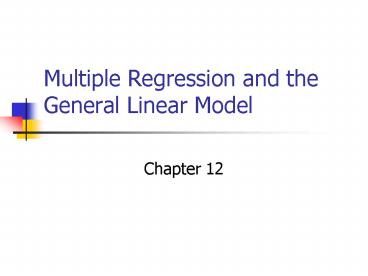Multiple Regression and the General Linear Model - PowerPoint PPT Presentation
1 / 33
Title:
Multiple Regression and the General Linear Model
Description:
Which Model is the 'Best ? ... To compare models with different dependent variables, we use Predicted Mean Squares or PREDMS ... 'My R = .7 is that not super' ... – PowerPoint PPT presentation
Number of Views:81
Avg rating:3.0/5.0
Title: Multiple Regression and the General Linear Model
1
Multiple Regression and the General Linear Model
- Chapter 12
2
Figure 11.2 Theoretical Distribution of y in
Regression
3
Which Model is the Best ?
4
Which Model is the Best ?
Can you compare bell peppers and apples?
5
Which Model is the Best ?
- To compare models using RSQ both models must have
the same dependent variable - To compare models with different dependent
variables, we use Predicted Mean Squares or PREDMS
6
PREDMS
For the original model, we use
7
PREDMS1
8
Example
9
Problem Points
- High Leverage Point
- High Influence Point
10
Figure 11.11(a) High Influence Points
11
Figure 11.11(b) Low Influence Points
12
Diagnostic Measures
- Residuals
- Residual Standard Deviation
- Sample standard deviation around the regression
line, the standard error of estimate, or the
residual standard deviation.
13
SPSS
- Cooks D
- Leverage Points
14
Multiple Regression Model
- Cross-Product Term equal to x1x2
- First-Order Model
- Partial Slopes
15
Assumptions for Multiple Regression
- The mathematical form of the relation is correct,
so for all i. - Var for all i.
- The s are independent.
- is normally distributed.
16
General Linear Model
17
Estimating Multiple Regression Coefficients
- Least-squares prediction equation
- Minimize
18
Residual Standard Deviation
- Residual Standard Deviation
19
Coefficient of Determination
- Coefficient of determination, R2
20
Definition 12.2
21
R versus R2 versus Adjusted R2
- My R .7 is that not super
- No, you have only explained 49 of the variation
in Y there is 51 unexplained - Adjusted R2 an index to keep you honest
22
Adjusted R2
- Adjusted R2 1- (1 - R2 )((n - 1)/(n - k - 1))
- where
- R2 Coefficient of Determination
- n number of observations
- k number of Independent Variables
23
F Test of H0
- H0
- Ha At least one
- T.S.
- R.R. With df1k and df2n-(k1), reject H0 if
- FgtF .
- Check assumptions and draw conclusions.
24
Definition 12.3
- Estimated standard error of in a multiple
regression - where is the value obtained
by letting xj be the dependent variable in a
multiple regression, with all other xs
independent variables. Note that is the
residual standard deviation for the multiple
regression of y on - .
25
Collinearity
- When the independent variables are themselves
correlated, collinearity (sometimes called
multicollinearity) is present
26
Effect of Collinearity
- is by definition very
large and 1- is near zero. Division by a
near-zero number yields a very large standard
error.
27
Variance Inflation Factor
- The term 1/(1- )
- If the VIF is very large, such as 10 or more,
collinearity is a serious problem.
28
Definition 12.4
- The confidence interval for is
- where cuts off area in the tail of
a t distribution with df , the
error df.
29
Interpretation of H0
- The usual null hypothesis for inference about
is . This hypothesis does not assert that
has no predictive value by itself. It
asserts that it has no additional predictive
value over and above that contributed by the
other independent variables.
30
Summary for Testing
- H0 1. Ha 1.
- 2. 2.
- 3. 3.
- T.S. R.R. 1.
- 2.
- 3.
- where t? cuts off a right-tail area a in the t
distribution with df n-(k1). - Check assumptions and draw conclusions.
31
F Test of a Subset of Predictors
- H0
- Ha H0 is not true.
- T.S.
- R.R. ,where cuts off a
right-tail area of the F distribution with
df1(k-g) and df2n-(k1). - Check assumptions and draw conclusions.
32
Forecasting Using Multiple Regression
- Confidence Interval
- Prediction Interval
33
Extrapolation in Multiple Regression































